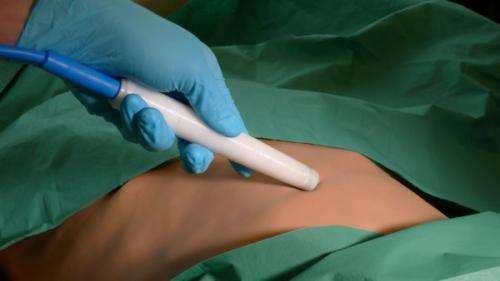Radiation-free method to track suspicious lymph nodes in case of cancer

Researchers at the UT Research Institute MIRA have developed a new method for tracing the sentinel lymph node, the node by which you can tell whether a patient's cancer has spread. Martijn Visscher demonstrated that you can find the node using magnetic nanoparticles, a simple set-up and a clever way of measuring. The patented find, which can quickly be put into practice, will prevent patients from being unnecessarily exposed to ionizing radiation. Visscher will obtain his doctoral degree on 27 August.
In order to determine whether a patient suffering from cancer has metastases, doctors will start looking for the sentinel lymph node, the first lymph node after the tumour. When cells break free from the tumour, that's where they go first. Therefore, if a patient has a 'clean' sentinel lymph node, the cancer has essentially not spread. Right now, tracking this node generally occurs with the help of radioactive particles. Downside to this method is that you expose the patient to damaging radiation. Because the particles are very perishable and potentially dangerous, they're a logistic nightmare: both in the area of transport and the scheduling of surgeries (in addition, many patients remain deprived of the particles because there's no suitable nuclear facility in the vicinity). In the Netherlands, thousands of cancer patients undergo the sentinel lymph node procedure every year.
Magnetic nanoparticles
Martijn Visscher of the University of Twente developed a method with which you can track down the node with the help of magnetic nanoparticles: little pieces of iron oxide, 30 to 100 nanometres in size (a nanometre is a million times smaller than a millimetre).
The particles are injected near the tumour and pile up on the sentinel lymph node, where they emit a very weak magnetic field. However, this is very difficult to detect, because the surrounding tissue is also emitting a weak magnetic field. Earlier research has shown that you can use the particles to find nodes very close to the surface, but no one had yet succeeded in achieving the same results for the deeper-lying nodes that frequently occur in practice. Visscher's research is a step closer to this result.
He developed a method with which you - using a clever mathematical trick and the fact that the magnetic properties of particles and the body are not exactly the same - can measure much more accurately using only a simple set-up. With this you can detect a small amount of magnetic nanoparticles in a large volume of tissue. A patent has been granted for this method, which has been named differential magnetometry.
Medical practice
The nanoparticles used are harmless. Because medical personnel are currently already using them as contrast fluid for an MRI, you can relatively easily put differential magnetometry into medical practice. Dr. ir. Bennie ten Haken of the Neuroimaging (NIM) department, Visscher's direct supervisor, expects that the method will quickly be ready for use. "This magnetic technique can also find the deeper-lying nodes in patients on the operating table. With that, this technique makes the most reliable (follow-up) treatment for breast cancer patients possible. Considering the low cost price of all parts, the simple logistics and the increase in patient safety I expect that within ten years this method can develop into the preferred method for all hospitals in the Netherlands and beyond."
In the long term, the detection method developed by Visscher will probably be suited for other applications as well. If you can connect the nanoparticles to specific antibodies you can, for example, also use them to track down tumours directly.















